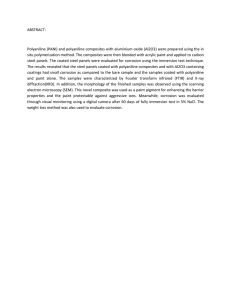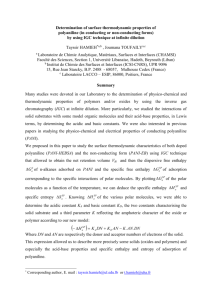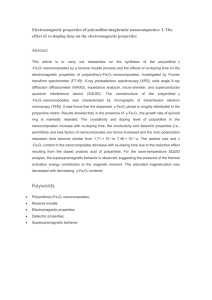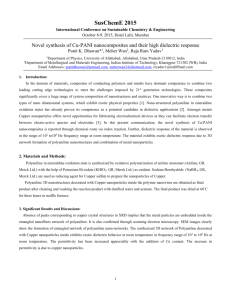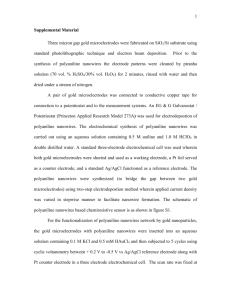Corrosion Protection of Carbon Steel Using Polyaniline Composite with Aluminium Oxide
advertisement
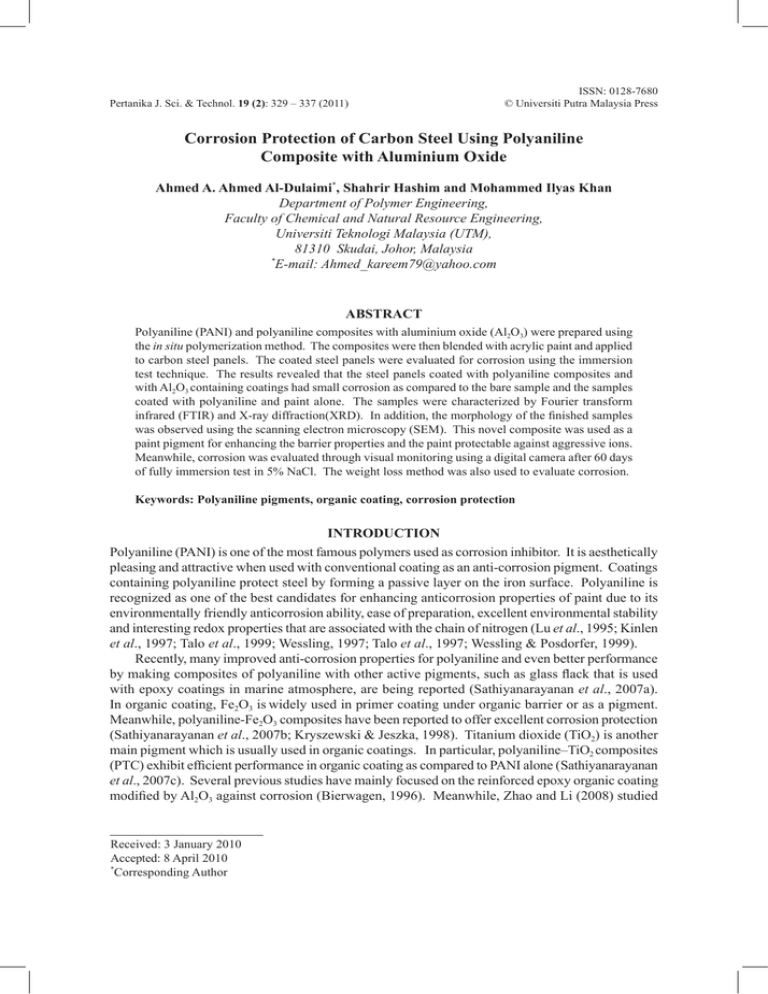
Pertanika J. Sci. & Technol. 19 (2): 329 – 337 (2011) ISSN: 0128-7680 © Universiti Putra Malaysia Press Corrosion Protection of Carbon Steel Using Polyaniline Composite with Aluminium Oxide Ahmed A. Ahmed Al-Dulaimi*, Shahrir Hashim and Mohammed Ilyas Khan Department of Polymer Engineering, Faculty of Chemical and Natural Resource Engineering, Universiti Teknologi Malaysia (UTM), 81310 Skudai, Johor, Malaysia * E-mail: Ahmed_kareem79@yahoo.com ABSTRACT Polyaniline (PANI) and polyaniline composites with aluminium oxide (Al2O3) were prepared using the in situ polymerization method. The composites were then blended with acrylic paint and applied to carbon steel panels. The coated steel panels were evaluated for corrosion using the immersion test technique. The results revealed that the steel panels coated with polyaniline composites and with Al2O3 containing coatings had small corrosion as compared to the bare sample and the samples coated with polyaniline and paint alone. The samples were characterized by Fourier transform infrared (FTIR) and X-ray diffraction(XRD). In addition, the morphology of the finished samples was observed using the scanning electron microscopy (SEM). This novel composite was used as a paint pigment for enhancing the barrier properties and the paint protectable against aggressive ions. Meanwhile, corrosion was evaluated through visual monitoring using a digital camera after 60 days of fully immersion test in 5% NaCl. The weight loss method was also used to evaluate corrosion. Keywords: Polyaniline pigments, organic coating, corrosion protection INTRODUCTION Polyaniline (PANI) is one of the most famous polymers used as corrosion inhibitor. It is aesthetically pleasing and attractive when used with conventional coating as an anti-corrosion pigment. Coatings containing polyaniline protect steel by forming a passive layer on the iron surface. Polyaniline is recognized as one of the best candidates for enhancing anticorrosion properties of paint due to its environmentally friendly anticorrosion ability, ease of preparation, excellent environmental stability and interesting redox properties that are associated with the chain of nitrogen (Lu et al., 1995; Kinlen et al., 1997; Talo et al., 1999; Wessling, 1997; Talo et al., 1997; Wessling & Posdorfer, 1999). Recently, many improved anti-corrosion properties for polyaniline and even better performance by making composites of polyaniline with other active pigments, such as glass flack that is used with epoxy coatings in marine atmosphere, are being reported (Sathiyanarayanan et al., 2007a). In organic coating, Fe2O3 is widely used in primer coating under organic barrier or as a pigment. Meanwhile, polyaniline-Fe2O3 composites have been reported to offer excellent corrosion protection (Sathiyanarayanan et al., 2007b; Kryszewski & Jeszka, 1998). Titanium dioxide (TiO2) is another main pigment which is usually used in organic coatings. In particular, polyaniline–TiO2 composites (PTC) exhibit efficient performance in organic coating as compared to PANI alone (Sathiyanarayanan et al., 2007c). Several previous studies have mainly focused on the reinforced epoxy organic coating modified by Al2O3 against corrosion (Bierwagen, 1996). Meanwhile, Zhao and Li (2008) studied Received: 3 January 2010 Accepted: 8 April 2010 * Corresponding Author Ahmed A. Ahmed Al-Dulaimi, Shahrir Hashim and Mohammed Ilyas Khan some important properties of Al2O3-PANI, such as electrical conductivity, thermal stability and the effect of water absorption on the mechanical and dielectric properties of the composites. This study was carried out to synthesize and characterize PANI and PANI-Al2O3, as well as compare their anti-corrosion performance using the immersion tests on acid media. METHODOLOGY Materials The monomer aniline was provided by Mallinckrodt U.S.A, whereas dopant phosphoric acid (H3PO4) was provided by MERCK, Germany and the composite of Al2O3 was provided by Fisher Scientific, U.K. Ammonium persulphate (NH4)2S2O8 was provided by QRëC, acrylic paint, paint coating (Nippon paint), while sodium chloride (NaCl) for the immersion test was obtained from MERCK, Germany and carbon steel plates were provided by a local factory in Malaysia. Synthesis of PANI and Composite of PANI- Al2O3 Initially, 18.6g of aniline was dissolved in 200ml of 1 M solution of phosphoric acid. Later, Al2O3 powder was added for the preparation of the composites. After adding the powder into the solution, the mixture was stirred for 30 minutes to separate the powder from the aggregation. Pre-cooled 200 ml of 1 M solution of ammonium persulfate was dropped into the pre-cooled solution (aniline-acid) for about 2 hours with a constant stirring. The reaction was conducted at 5±1°C. After a complete dropping of ammonium persulfate, the stirring was continued further for 3 more hours to ensure a complete polymerization. A dark green coloured polyaniline (see Fig. 1) was collected on a Büchner funnel, and the cake was washed several times with de-ionized water to remove excessive acid content until the filtrate became almost colourless. The polymer was dried in an oven at about 55°C for 24 hours. The dried PANI and PANI-Al2O3 composites were finely ground using a mortar before they were used as pigments. Pigments (PANI and composite of PANI-Al2O3) Characterization The pigments synthesized were characterized by the FTIR spectra, in which the two pigments were taken with the KBr pellets using Perkin Elmer FTIR Spectrometer in the range of 3000–550 cm−1. The pigments were also analyzed using the X-ray diffraction method and Siemens (Diffraktometer D5000) X-ray. Meanwhile, the scanning electron microscopy (SEM) JEOL (JSM-6390LV) was used for the morphological examination of the two pigments. As for the SEM analysis, each pigment was dispersed over a copper block in four parts. Fig. 1: Polyaniline protonation 330 Pertanika J. Sci. & Technol. Vol. 19 (2) 2011 Corrosion Protection of Carbon Steel Using Polyaniline Composite with Aluminium Oxide Blending and Preparation of the Paint Containing the Pigments The coatings were prepared using solvent based vinyl acrylate wall sealer. The pigments were finely ground hand mortar and mixed with primer using lab attritor for 45 minutes. The loading of the pigments (PANI, PANI-Al2O3) was kept at 15% by volume with 25% of acrylic paint. The prepared coatings were kept in air tight jar to avoid any solvent evaporation and the formation of paint gel. Studies of Coating Rust Gain The total paint system was applied over circles carbon steel plates using dip technique and allowed to dryness for two days at a suitable temperature. Three types of the samples were prepared for this test, and each comprised of five specimens. These coated panels were weighed using an electronic balance (Precisa, Model XT220), before and after the immersion test, with an accuracy of 0.1 mg. After finishing the immersion test periods for 60 days, again the samples were weighted. Rust deposit for every sample was examined after 60 days. Evaluation of the Coating by Total Immersion Testing The coated samples were immersed in 5% sodium chloride solution for a period of 60 days. The performance of the coating was visually examined. The anticorrosion properties of the coatings were evaluated using the total immersion test according to ASTM G31. The samples were taken out and cleaned according to ASTM G1 and weighed again. The procedure used for cleaning the samples consists of two steps. In the first step, the coatings were removed using acetone as a solvent, while in the second step, the corrosion products were removed by taking 500 mL of hydrochloric acid (HCl, specific gravity 1.19) to which 3.5 g of hexamethylene tetramine was added. Distilled water was added to make it 1000 mL. The samples were dipped for 10 min at room temperature and cleaned with brush. The weight loss method was adopted to evaluate the corrosion rate. The calculated values of the weight loss are shown in Table 1. The equation for the weight loss method is as below. Evaluation of the Coating by Total Immersion Testing The coated samples were immersed in 5% sodium chloride solution for a period of 60 days. The performance of the coating was visually examined. The anticorrosion properties of the coatings were evaluated using the total immersion test according to ASTM G31. The samples were taken out and cleaned according to ASTM G1 and weighed again. The procedure of cleaning the samples consists of two steps. In the first step coatings were removed by using acetone as a solvent and in second step corrosion product were removed by taking 500 mL of hydrochloric acid (HCl, specific gravity 1.19) to which 3.5 g of hexamethylene tetramine was added. Distilled water was added to make it 1000 mL. The samples were dipped for 10 min at room temperature and cleaned with brush. The weight loss method was adopted to evaluate the corrosion rate. The calculated values of weight loss are shown in Table 1. The equation for weight loss method is as below. Corrosion Rate K.W A.T.D (1) K = a constant, T = time of exposure, A = area in cm2, W = mass loss and D = density Pertanika J. Sci. & Technol. Vol. 19 (2) 2011 331 Ahmed A. Ahmed Al-Dulaimi, Shahrir Hashim and Mohammed Ilyas Khan TABLE 1 Average value of losing weigh Paint system Average value of losing weight (g) Paint alone 91 mg Paint PANI modified 60 mg Paint PANI- Al2O3 modified 28 mg RESULTS AND DISCUSSION Fourier Transform Infrared (FTIR) The FTIR spectra examination of PANI and PANI-Al2O3 revealed that the composites contain all the main characteristics of polyaniline bands. The bands around 1600 (Tang et al., 1988) and 1500 cm−1 (Cao et al., 1986) are the stretching mode of C=N and C=C, while the bands around 1300 and 1250 cm−1 (Sathiyanarayanan et al., 2007c) are to C–N stretching mode of benzenoid ring and the band at 1105.5 cm−1 is assigned to a plane bending vibration of C–H mode which is found during protonation (Kang et al., 1998). In the case of polyaniline composites with Al2O3, the spectrum, the composites have been shown to contain all the main characteristics of the PANI bands, except for C-H peak at 1105.5 cm-1; these peaks are found to be slightly shifted to be at 1108.5 cm-1 as compared to pure PANI, indicating significant interactions between polyaniline and Al2O3 (Teoh et al., 2007), as depicted in Fig. 2. X-ray Diffraction (XRD) The XRD patterns of Al2O3, PANI and the composition of PANI with Al2O3 suggest some similarities between the XRD patterns of two inorganic particles before the composite and almost similar to that after mixing with polyaniline. Furthermore, the broad diffraction peak of PANI at 2θ =25o is absent in the PANI-Al2O3, indicating that the presence of Al2O3 in the polymerization system strongly affects the crystalline behaviour of PANI form and the interaction of PANI with Al2O3 narrows the crystallization of PANI. This further indicates that PANI which has been deposited onto the surface of particles has no effect on the crystalline structure of Al2O3 and a similar observation on the XRD pattern has been reported for polyaniline– Al2O3 composites illustrated in Fig. 3. Scanning Electron Micrographs (SEM) The scanning electron micrographs of the Al2O3 particles alone and modified with PANI are shown in Fig. 4. It can be seen that PANI appears in the surface of alumina particles flake. In addition, the flake like the particles of Al2O3 are covered by the polyaniline spheres which are deposited and encapsulated upon the surface of the Al2O3 particles, as shown in Fig. 4. 332 Pertanika J. Sci. & Technol. Vol. 19 (2) 2011 Corrosion Protection of Carbon Steel Using Polyaniline Composite with Aluminium Oxide Fig. 2: FTIR spectra of polyaniline and polyaniline-Al2O3 Pertanika J. Sci. & Technol. Vol. 19 (2) 2011 333 Ahmed A. Ahmed Al-Dulaimi, Shahrir Hashim and Mohammed Ilyas Khan 9000 8000 7000 Ln (Cps) 6000 5000 4000 3000 2000 1000 0 10 20 30 40 50 60 70 80 90 2-Thota-Scale Fig. 3: The XRD of the samples, before and after synthesis polyaniline Fig. 4: The SEM samples, before and after composite (a)PANI, (b) Al2O3 and (c) PANI-Al2O3 Coating Evaluation Weight loss study At the end of immersion period, the samples were taken out and observed. The photographs of the samples are shown in Fig. 5. Meanwhile, the average values of the samples weight loss are shown in Table 1 and in Fig. 6. The results reveal that the paint which was modified with PANI- Al2O3 composite has a better effect on the anti-corrosion function. 334 Pertanika J. Sci. & Technol. Vol. 19 (2) 2011 Corrosion Protection of Carbon Steel Using Polyaniline Composite with Aluminium Oxide Fig. 5: The samples after 60 days of full immerison test in 5% NaCl, (a) pain alon, (b) paint modified with PANI, (c) paint modified with PANI PANI- Al2O3 composite Fig. 6: Weight loss by the different coated steel panels Pertanika J. Sci. & Technol. Vol. 19 (2) 2011 335 Ahmed A. Ahmed Al-Dulaimi, Shahrir Hashim and Mohammed Ilyas Khan CONCLUSIONS In this work, polyaniline (PANI) and polyaniline composites, with aluminium oxide (PANI-Al2O3), were prepared using the situ-polymerization technique and used as anticorrosive pigments in the acrylic paint system to be applied on the carbon steel samples. The pigments were characterized by the FTIR, XRD, and SEM. Meanwhile, the anticorrosion ability of the coating was evaluated using the totally immersion test sodium chloride solution according to ASTM G31 standard and calculating the average weight loss method. Polyaniline modified Al2O3 particles containing paint showed better results than polyaniline alone in terms of corrosion protection of the carbon steel samples. ACKNOWLEDGEMENT The authors would like to express a sincere appreciation to Universiti Teknologi Malaysia (UTM) and the Department of Polymer Engineering for the laboratory facilities and technical support rendered throughout the study. We would also like to thank the Research Management Centre, UTM, for the financial support through the grant number 77511. REFERENCES Bierwagen, G. P. (1996). Reflections on corrosion control by organic coatings. Progress in Organic Coatings, 28, 43-48. Cao, Y., Li, S., Xue, Z., & Guo, D. (1986). Spectroscopic and electrical characterization of some aniline oligomers and polyaniline. Synthetic Metals, 16, 305-315. Kang, E. T., Neoh, K. G., & Tan , K. L. (1998) Polyaniline: A polymer with many interesting intrinsic redox states. Progress in Polymer Science, 23, 277-324. Kinlen, P.J., Silverman, D., & Jeffreys, C.R. (1997). Corrosion protection using polyaniline coating formulations. Synthetic Metals, 85, 1327-1332. Kryszewski, M., & Jeszka, J.K. (1998). Nano-structured conducting polymer composites – superparamagnetic particles in conducting polymers. Synthetic Metals, 94, 99-104. Lu, W., Elsenbaumer, R. L., & Wessling, B. (1995). Corrosion protection of mild steel by coatings containing polyaniline. Synthetic Metals, 71, 2163-2166. Sathiyanarayanan, S., Azim, S. S., & Venkatachari, G. (2007a). Corrosion protection coating containing polyaniline glass flake composite for steel. Electrochimica Acta, 53, 2087–2094. Sathiyanarayanan, S., Azim, S., & Venkatachari, G. (2007b). Preparation of polyaniline–Fe2O3 composite and its anticorrosion performance. Synthetic Metals, 157, 751–757. Sathiyanarayanan, S., Azim, S. S., & Venkatachari, G. (2007c). Preparation of polyaniline–TiO2 composite and its comparative corrosion protection performance with polyaniline. Synthetic Metals, 157, 205–213. Talo, A., Forsen, O., & Ylasaari, S. (1999). Corrosion protective polyaniline epoxy blend coatings on mild steel. Synthetic Metals, 102, 1394-1395. Talo, A., Passiniemi, P., Forsen, O., & Ylasaari, S. (1997). Polyaniline/epoxy coatings with good anti-corrosion properties. Synthetic Metals, 85, 1333-1334. Tang, S., Jing, X.B., Wang, B.C., & Wang, F. (1988). Infrared spectra of soluble polyaniline. Synthetic Metals, 24, 231 – 238. Teoh, G.L., Liew, K.Y., & Mahmood, W.A.K. (2007). Preparation of polyaniline-Al2O3 composites nanofibers with controllable conductivity. Materials Letters 61, 4947–4949. 336 Pertanika J. Sci. & Technol. Vol. 19 (2) 2011 Corrosion Protection of Carbon Steel Using Polyaniline Composite with Aluminium Oxide Wessling, B. (1997). Scientific and commercial breakthrough for organic metals. Synthetic metals, 85, 13131318. Wessling, B., & Posdorfer, J. (1999). Polyaniline/epoxy coatings with good anti-corrosion properties. Synthetic Metals, 102, 1400-1401. Zhao, H., & Li. R. K.Y. (2008). Effect of water absorption on the mechanical and dielectric properties of nano-alumina filled epoxy nanocomposites. Composites, Part A 39, 602–611. Pertanika J. Sci. & Technol. Vol. 19 (2) 2011 337
